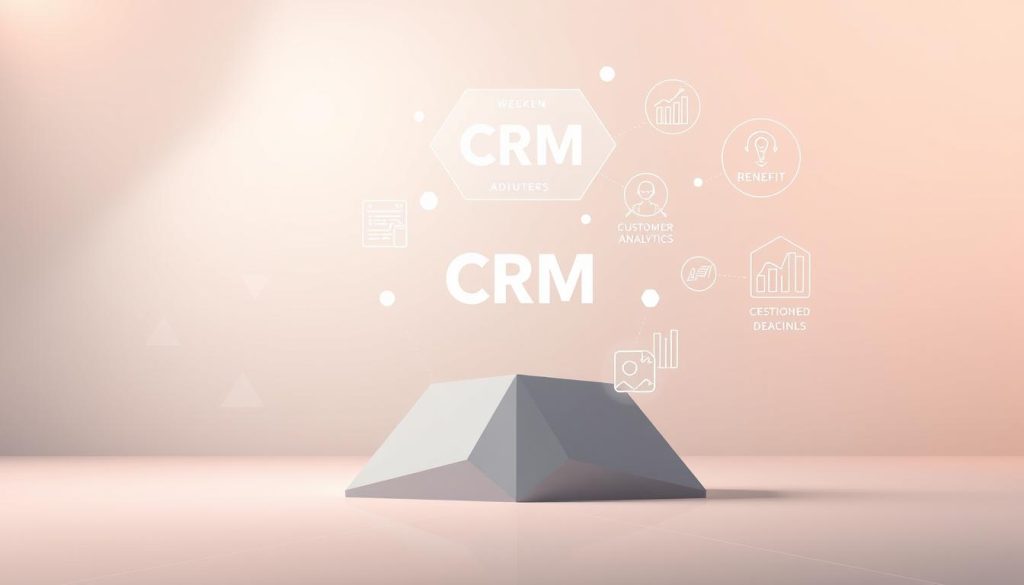Building strong connections with your customers is more critical than ever. This comprehensive guide explores powerful strategies that transform how companies interact with people throughout their entire journey.
Modern approaches to customer relationship management blend centralization, automation, and optimization. The goal is to create seamless experiences that drive significant business growth.
You will discover actionable methods for implementing CRM systems that align with your core business objectives. These strategies improve satisfaction and boost operational efficiency simultaneously.
The landscape of relationship management continues to evolve rapidly. This resource covers the complete spectrum, from initial planning and technology selection to training and ongoing optimization.
Practical examples show how these strategies directly impact revenue growth and competitive positioning. This guide is valuable for businesses of all sizes seeking sustainable success.
Table of Contents
Key Takeaways
- Strong customer relationships are fundamental to modern business growth.
- Effective strategies centralize and automate interactions for a seamless experience.
- Proper implementation aligns technology with core business goals.
- A well-executed plan improves both customer satisfaction and operational efficiency.
- The approach is dynamic, requiring continuous optimization for best results.
- These methods are scalable and beneficial for organizations of any size.
- Strategic relationship management directly influences revenue and market position.
Introduction to Effective Client Relations Management Strategies
Modern businesses face a critical challenge: turning vast amounts of customer data into meaningful, profitable interactions. Customer expectations are higher than ever, making a strategic approach essential for survival and growth.
Research highlights a significant problem. In France, 48.8% of companies miss commercial opportunities because their customer information is fragmented. This lack of clear visibility hinders effective decision-making.
The average organization uses nearly 1,000 different applications. However, only 28% of these tools work together seamlessly. This creates major obstacles for teams trying to coordinate their efforts.
Customer relationship management (CRM) systems are designed to solve these integration challenges. They move beyond simple contact lists to become powerful platforms for managing every customer interaction.
This evolution transforms how businesses operate. A modern CRM centralizes information, automates key processes, and creates a unified view of the customer journey.
| Business Challenge | Impact | CRM Solution |
|---|---|---|
| Fragmented customer data | Lost sales opportunities | Centralized database |
| Disconnected applications | Inefficient teamwork | Seamless integration |
| Limited visibility | Poor customer experiences | Complete interaction history |
Implementing a CRM strategy addresses these core issues directly. It connects teams and provides the insights needed to build stronger, more profitable relationships with clients.
Client Relations Management: Definition and Benefits
The evolution of CRM has transformed it from simple contact management to a comprehensive business strategy. This approach combines technology with customer-focused processes.
Understanding the CRM Concept
Customer Relationship Management represents both a business philosophy and technological solution. It encompasses tools for managing all interactions throughout the sales cycle.
The framework stands on three fundamental pillars. Centralization brings all customer data into one accessible location. Automation handles repetitive tasks efficiently. Optimization continuously improves the customer experience.

Key Benefits for Customer Satisfaction
CRM systems enable highly personalized experiences for each individual. They create consistency across all communication channels and touchpoints.
Businesses gain a complete view of each customer’s preferences and history. This understanding allows for anticipating needs rather than reacting to problems. The result is stronger loyalty and improved retention rates.
| CRM Pillar | Primary Function | Customer Impact |
|---|---|---|
| Centralization | Unifies all customer information | Consistent service across teams |
| Automation | Streamlines routine processes | Faster response times |
| Optimization | Improves interaction quality | Personalized experiences |
Building a Strategic CRM Foundation
A successful CRM system begins with a clear strategic foundation, not just software installation. This groundwork ensures technology serves your business goals effectively.
Before choosing any tools, you must define what success looks like. This strategic alignment is the true engine of growth.
Identifying Business Objectives
Start by setting specific, measurable goals for your relationship management efforts. Common targets include boosting conversion rates and shortening sales cycles.
Increasing customer retention is another powerful objective. Clear goals guide your entire process and justify the investment.
Mapping the Customer Journey
Adopt a customer-centric view by mapping every step a prospect takes. Document the path from initial awareness to post-purchase support.
This reveals critical touchpoints where interactions shape the overall customer experience. It helps eliminate friction and smooth transitions between teams.
| Component | Key Activity | Strategic Outcome |
|---|---|---|
| Business Objectives | Define measurable goals (e.g., conversion rate) | Clear direction for CRM implementation |
| Customer Journey | Map all prospect and client touchpoints | Optimized, seamless customer experience |
| Data Alignment | Connect goals to data collection points | Actionable insights for continuous improvement |
This foundational work is crucial for long-term success. For more on creating robust business strategies, explore these expert client management tips.
A strong foundation turns your CRM into a powerful asset for managing your sales pipeline and nurturing valuable client relationships.
Leveraging Technology and CRM Software
Cloud technology has revolutionized CRM software, making sophisticated tools accessible to businesses of all sizes. This modern approach eliminates traditional barriers to implementation.

Cloud-Based Solutions for Modern Businesses
Cloud-based CRM systems provide secure access from any location. Team members can update customer information in real time. This ensures everyone works with current data.
The cloud solution removes hardware requirements. This significantly reduces costs for organizations. Subscription pricing makes budget planning predictable.
Scalability is another key advantage. You only pay for the features and seats you need. Your CRM system grows alongside your business.
Integrating Existing Business Tools
Effective management software connects seamlessly with other applications. Integration prevents data silos from forming. Information flows smoothly between departments.
Modern platforms offer APIs and pre-built connectors. These tools help link your CRM with marketing and accounting systems. The right solution creates a unified technology ecosystem.
Careful planning ensures your new system works well with existing tools. This approach maintains information consistency across the organization.
Optimizing Customer Communication and Engagement
Today’s customers expect seamless interactions across every touchpoint, making unified communication systems essential for business success. Modern platforms synchronize all contact methods within a single interface.
This approach ensures consistent messaging regardless of how people choose to connect. Businesses gain complete visibility into every customer conversation.
Multi-Channel Communication Strategies
CRM technology unifies diverse channels like email, SMS, phone calls, and live chat. All communications align within one centralized platform. This synchronization prevents fragmented customer experiences.
Companies can select the optimal channel for each contact based on context and urgency. The system maintains message coherence across all platforms. Personalized service becomes achievable at scale.
Research shows 70% of consumers expect representatives to know their complete history. Centralized communication records eliminate repetitive explanations. Customers feel valued when service teams have full context.
Effective multi-channel strategies combine technological integration with thoughtful planning. The result is seamless customer service that builds lasting relationships. Businesses that master this approach gain significant competitive advantages.
Enhancing Data Centralization and Analytical Insights
Without reliable data management, even the most sophisticated CRM tools cannot deliver meaningful results. The quality of your customer information directly impacts every aspect of your business operations.

Clean, accurate data forms the foundation for successful decision-making. Regular maintenance prevents the accumulation of obsolete or incorrect information.
Maintaining Data Quality and Segmentation
Implementing rigorous data hygiene practices ensures accuracy and completeness. Clear procedures for data entry and regular database cleaning are essential.
CRM systems centralize diverse information from multiple sources. This includes prospect details, company information, and complete interaction histories.
Advanced segmentation techniques group clients based on behaviors and engagement levels. This enables targeted marketing campaigns and personalized approaches.
Proper segmentation allows businesses to create customized experiences for specific customer groups. These strategies resonate more effectively with different audiences.
Analytical insights from centralized data reveal patterns and trends. This information would remain hidden in fragmented systems. For comprehensive guidance on managing client relationships effectively, explore our detailed resources.
Data quality directly impacts forecasting reliability and personalization effectiveness. Clean information ensures your business decisions are based on current, accurate insights.
Integrating AI and Automation for CRM Success
Modern CRM platforms are evolving from passive databases into proactive business intelligence engines through AI integration. This transformation enables unprecedented levels of predictive analysis and operational efficiency.
Harnessing AI for Predictive Analytics
Artificial intelligence algorithms analyze vast amounts of customer data to identify behavioral patterns. These systems predict future needs with remarkable accuracy.
AI-enhanced lead scoring evaluates thousands of variables simultaneously. This determines which prospects deserve priority attention based on conversion probability.
Automating Routine Processes
Automation eliminates time-consuming administrative tasks like data entry and meeting scheduling. Workflow automation ensures consistent execution of multi-step processes.
AI-powered virtual assistants handle routine inquiries and provide 24/7 support. This frees employees to focus on relationship-building activities.
| Technology | Primary Function | Business Impact |
|---|---|---|
| Artificial Intelligence | Predictive analysis and pattern recognition | Anticipates customer needs and optimizes targeting |
| Automation | Streamlines repetitive tasks and workflows | Increases efficiency and reduces human error |
| Combined Solution | Intelligent process optimization | Boosts conversion rates by up to 300% |
Successful implementation requires strategic planning to identify which processes benefit most from these technologies. For comprehensive guidance on optimizing your approach, explore our resources on effective client management strategies.
Adapting CRM Solutions for All Business Sizes
Finding the right customer relationship tool should not depend on your company’s employee count. Effective systems exist for organizations of every scale, from solo entrepreneurs to multinational corporations.

Tailored Options for Small and Midsize Businesses
Many smaller organizations still rely on basic tools for customer information. Research shows one in four SMEs manages contacts using Excel spreadsheets.
Several affordable options exist for growing businesses. Desktop systems work well for individual users. Workgroup solutions support small teams effectively.
Cloud-based platforms offer the most flexibility. They provide enterprise features at accessible price points. These systems allow gradual expansion as needs evolve.
Scalable Solutions for Large Enterprises
Major corporations require robust systems handling thousands of contacts. Enterprise-grade CRM platforms manage complex organizational structures.
These comprehensive solutions offer advanced functionality. They include multi-level permissions and sophisticated reporting tools. Extensive integration capabilities connect various business units.
The key to successful implementation lies in selecting tools matched to current needs. Choose platforms with room for future growth to avoid disruptive migrations.
Driving Sales Pipeline and Customer Retention
The true measure of a CRM’s success lies in its direct impact on revenue growth through a healthy sales pipeline and strong customer retention. These two elements form a powerful growth engine that is more effective than focusing on either one alone.
A robust system provides complete visibility into the entire sales process. This allows for accurate forecasting and strategic resource allocation.
Optimizing Lead Generation and Conversion
CRM tools are essential for modern marketing. They help create targeted campaigns and capture qualified leads from multiple channels.
The journey of a prospect is visualized in the sales pipeline. It maps stages from initial contact to final purchase. This includes needs analysis, evaluation, and negotiation.
Automated workflows nurture prospects through longer cycles. This maintains engagement and improves conversion rates. Sales teams can identify bottlenecks to keep the pipeline flowing smoothly.
| Strategy Focus | Primary CRM Tools | Key Business Outcome |
|---|---|---|
| New Customer Acquisition | Marketing automation, lead scoring, pipeline management | Increased revenue from new sources |
| Existing Customer Retention | Satisfaction tracking, renewal alerts, service history | Higher lifetime value and reduced churn |
Retention is equally critical. Tracking satisfaction provides early warnings. This allows businesses to address concerns before a client leaves.
By optimizing both strategies, companies build a sustainable future. For a deeper dive into these techniques, explore our guide on advanced client management.
Overcoming CRM Implementation Challenges
The transition to a CRM system presents unique hurdles that demand strategic approaches. Even the most sophisticated tools generate no value without proper team adoption.
Effective Training and Change Management
Successful implementation begins by collecting feedback from concerned teams early in the process. This ensures the selected solution addresses real workflow needs.
Solid internal communication lifts potential barriers and encourages adoption. Executive support facilitates necessary financial decisions and mobilizes teams effectively.
Dedicated training sessions accelerate integration into daily practices. Role-specific instruction and ongoing support resources help teams master the system.
Phased implementation reduces resistance by allowing mastery of core functionality first. Designating internal ambassadors provides peer assistance and builds collaboration.
View implementation as an ongoing process of refinement rather than a one-time deployment. Regular monitoring ensures the system remains effective for your organization’s needs.
Conclusion
Mastering customer relationship management represents a continuous evolution rather than a final destination. This strategic approach transforms how businesses connect with their customers across all touchpoints.
Effective CRM systems align technology, processes, and people around delivering exceptional customer experiences. The result is measurable business growth through improved customer satisfaction and enhanced sales performance.
Organizations of all sizes benefit from tailored solutions that grow with their needs. AI and automation capabilities further revolutionize how businesses understand and serve their customers.
View this as an ongoing journey of refinement. Regular assessment ensures your strategies remain effective in building lasting customer relationships that drive sustainable success.
FAQ
What is customer relationship management (CRM)?
Customer relationship management, or CRM, is a strategy and system for managing all your company’s interactions with current and potential customers. The goal is to improve business relationships to drive growth and customer satisfaction. It often involves using specialized software to centralize contact information, track communication, and automate sales and marketing processes.
How does CRM software improve customer service?
CRM software improves customer service by providing a single source of truth for all customer data. This allows support teams to quickly access a customer’s history, previous questions, and past interactions. With this information, agents can provide faster, more personalized support, leading to higher customer satisfaction and better retention rates.
What are the key benefits of using a CRM system?
The main benefits include better organization of customer information, streamlined communication, and improved sales pipeline management. These systems help automate tasks like sending emails, tracking leads, and nurturing prospects. This leads to more efficient processes, higher conversion rates, and stronger customer relationships.
Can small businesses benefit from CRM solutions?
Absolutely. Many CRM platforms offer tailored options and scalable solutions perfect for small and midsize businesses. These tools help organize contact details, manage leads, and automate marketing emails without a large upfront investment. They provide the foundation for professional relationship management and growth.
How does CRM help with lead generation and conversion?
CRM systems are powerful for managing leads and optimizing the conversion process. They help track where prospects come from, score leads based on engagement, and automate follow-up messages. This ensures no potential customer is forgotten and helps move leads efficiently through the sales pipeline.
What is the role of automation in modern CRM platforms?
Automation is a core feature of modern CRM software. It handles routine tasks like sending welcome emails, scheduling follow-ups, and updating customer records. This frees up your team to focus on high-value activities like closing deals and providing exceptional service, boosting overall performance.
How important is data quality in a CRM system?
A> Data quality is critical. Accurate and up-to-date customer information is the foundation for effective marketing, sales, and support. Clean data allows for proper segmentation, personalized communication, and reliable analytics. Regular maintenance of this data ensures your strategies are based on solid insights.
What are common challenges when implementing a new CRM?
Common challenges include user adoption and effective training. Some team members may resist changing their established workflows. Successful implementation requires clear communication about the benefits, comprehensive training sessions, and strong change management to ensure everyone uses the new system correctly.





